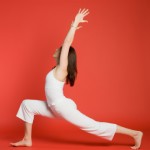 By Dr. Paul Jerard, E-RYT 500, YACEP
By Dr. Paul Jerard, E-RYT 500, YACEP
The term “flow Yoga” is an abbreviated form of the phrase “Vinyasa Flow Yoga.” This form of Yoga is based on movements synchronized with the breath. The word ‘flow’ refers to how the poses are strung together gracefully and how the Yoga practitioner moves with each breath while the sequence of movements comes together like a dance.
Surya Namaskar
Even though it is seen in many Hatha-style classes, one of the most popular sequences of Vinyasa Yoga is Surya Namaskar (the Sun Salutations). Many Yoga practitioners know this series, and its many variations, quite well. For anyone who wants to add flowing movement into his or her asana routine, this can be a great starting point.
Beyond Sun Salutations
Chandra Namaskar (Moon Salutations) may also interest anyone looking further into Vinyasa flows. Flow Yoga has many different forms, and it can be practiced in many different ways by changing speed, raising room temperature, or the posture sequence chosen. Slower Vinyasa Yoga (slow flow) can be extraordinarily therapeutic, healing, and restorative. There are also Restorative Flow Yoga classes, which leave students in a state of euphoria.
Variables
The pace of movement, and the use of props, can change the experience entirely. When you consider that some flow classes end with a five-minute relaxation, while a Restorative Flow class teaches relaxation methods, meditation, and traditional pranayama techniques, there can be vast differences in how Flow Yoga is taught. The repetition of movement helps to increase flexibility as much as holding a posture for minutes.
Teachers and Styles
Flow Yoga is, by nature, a different school of thought compared to styles that hold postures for lengthy periods. Styles that hold postures have their advantages, as well. Depending on how well you know the teacher, the movements can also be fairly unpredictable, thus creating a new or exciting environment. As there are many different interpretations teachers can take to this practice, it will be easy to find an instructor with whom you can identify.
Heat as a Factor
For those who crave intense exercise, the faster activity level of Flow Yoga, with increased speed and continuous movement, creates internal heat within the practitioner, which has many benefits. Increased heat means the body sweats, expelling toxins and promoting overall body cleansing. Heat also boosts metabolism so that it may burn some extra calories. The movement also stimulates blood flow and heart rate, creating a more healthy body by caring for many organs, and the warmth in the muscles makes them more limber and easy to stretch.
Pranayama
The breathing exercises (pranayama) in Flow Yoga are also very good for the body. Although some teachers may only focus on Ujjayi while you are moving, other teachers may devote extra time to pranayama practice. Learning and practicing pranayama is important as it gives you better control of your functions and increased focus on everything you do, bringing about a more relaxed mind and body. Learning to breathe in correct synchronization with your body can leave you better equipped to handle the tough situations life throws at you by helping you keep your stress levels in check.
Cardiovascular Health
When people think of Yoga, they often think of how it can improve their flexibility or muscle strength. However, many other benefits come with a regular Yoga practice – one of them being improvements to your cardiovascular health. Here are some of how Flow Yoga can help improve your heart health:
1. by increasing heart rate variability.
2. by improving circulation and blood pressure.
3. by helping to reduce stress and anxiety levels.
4. by improving lipid profiles.
5. by increasing levels of helpful antioxidants in the body.
Building Physical Strength
The practice of flow yoga has many advantages when it comes to building strength. One of the most important advantages is that it helps to improve your posture. Poor posture can lead to several problems, including back pain, neck pain, and headaches. By practicing flow yoga regularly, you can help to improve your posture and avoid these health problems.
Muscular Development
In addition to improving your posture, flow yoga can also help to increase your muscle strength. This type of yoga uses your body weight to resistance train your muscles, which can lead to increased muscle strength over time. Flow yoga can also help to improve your flexibility, which is another important factor in overall muscle health and function.
Conclusion
Flow Yoga has many faces. It can be a very challenging exercise class or a therapeutic experience. Chair Yoga classes have flowing movements. Conversely, some martial arts teams practice dynamic flowing Yoga sequences before tournaments. The point is: Flow Yoga can be dynamic or therapeutic. If you want to be sure about which end of the spectrum you are looking at, you should consult your local Yoga studio. If you are a Yoga teacher, label your class accordingly, and describe the experience your students should expect.
© Copyright – Aura Wellness Center – Publications Division
Please visit the following link to see our online Yoga teacher training courses.
https://aurawellnesscenter.com/store/
Are you interested in Meditation Teacher Training?
Click here to see our online Yoga Nidra teacher training course.
Are you an experienced teacher looking for YACEP credits or continuing education?
Subscribe to Our Newsletter for Special Discounts and New Products
Related Resources
52 Essential Principles of Yoga Philosophy to Deepen your Practice
by Rina Jakubowicz.
A Relaxing Way to De-stress, Re-energize, and Find Balance
by: Gail Boorstein Grossman.
YOGA: THE PATH TO HOLISTIC HEALTH
by B.K.S. Iyengar
TEACHING YOGA: Essential Foundations and Techniques
See our selection of affordable yoga teacher certification courses.

The breathing exercises in flow Yoga are very good for the body, as well. Thanks for sharing this nice post!
The repetition of movement helps to increase flexibility It can be a very challenging exercise class. Thanks for explaining about flow yoga. This is an informative article.